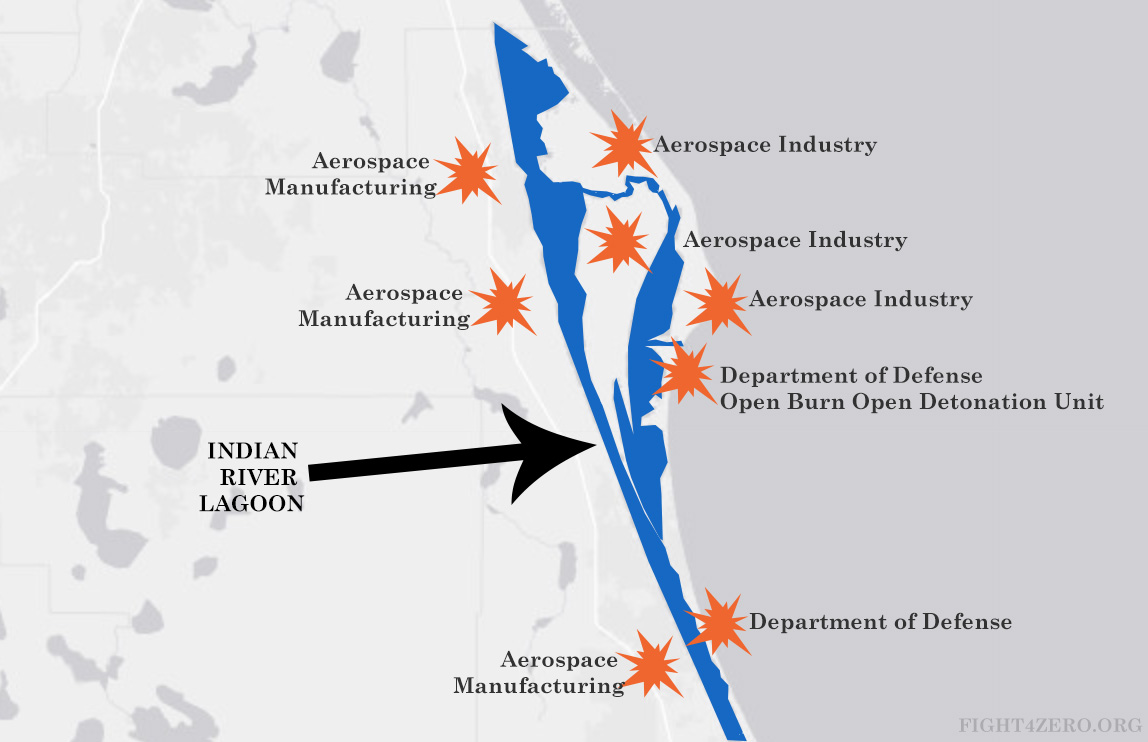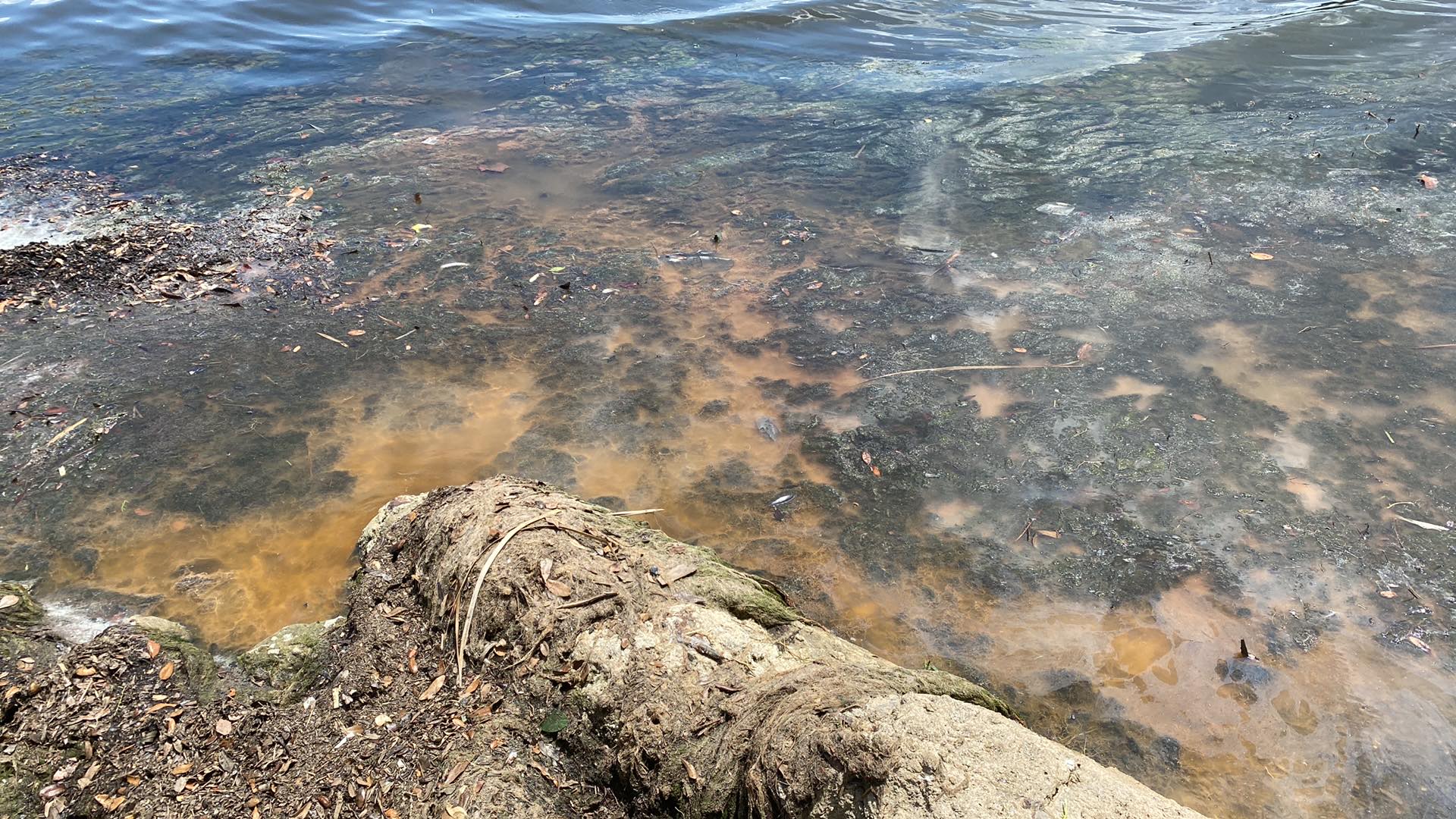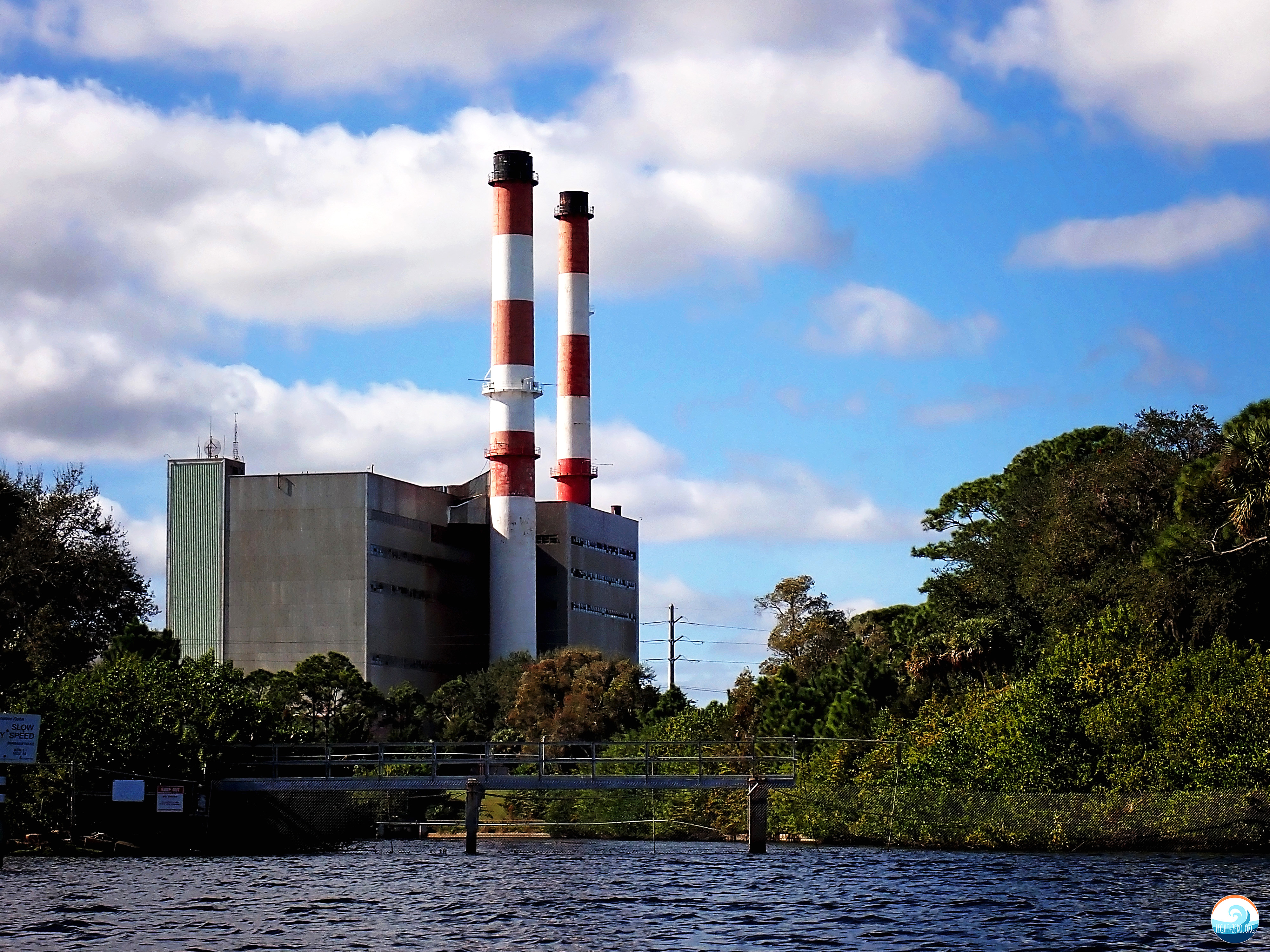BREVARD COUNTY, FL. - Florida's Space Coast may look like a paradise with its sun-drenched beaches and glistening waters, but a dark secret lurks beneath the surface. If you dive deep into research, you'll uncover intriguing parallels to the contamination found in Camp Lejeune, North Carolina. However, what makes it even more unsettling is the realization that Brevard County doesn't house just one military base but three: Kennedy Space Center, Cape Canaveral Space Force Station, and Patrick Space Force Base.
INDIAN RIVER LAGOON: The Indian River Lagoon, often mistaken for a river due to its lengthy appearance, is situated along these bases and is home to a troubling history of pollution. This expansive body of water is not just any estuary - it is a national treasure that the Environmental Protection Agency (EPA) committed to protecting. Back in 1990, this area received special designation to ensure the preservation of its ecosystems, but sadly, the current state of affairs tells a different story. Over the years, sewage, chemicals, and industrial waste have tainted the once pristine waters, robbing the habitat of its vibrant marine life like seahorses, stingrays, and manatees.
Decades ago, the waterways were a haven for local fishermen, but now they bear witness to the profound impact of pollution. The condition has worsened to the point where locals decided to impose a tax on themselves in 2016, all hoping to preserve whatever little was left of the waterways. The problem has become so widespread that even political leaders incorporate the Indian River Lagoon and its water quality concerns into their campaign rhetoric.
Over the last few decades, the seagrass population has drastically decreased, leading to manatees facing starvation and the declaration of an Unusual Mortality Event (UME) in 2021. Pollution has fueled harmful algal blooms, causing a decline in fisheries, while unchecked development is encroaching on wildlife habitats. The lagoon's shellfish have been found to have the highest concentration of microplastics in the world. Studies have shown an uptick in diseases like cancers, lesions, and tumors in dolphins, turtles, and fish. Parasites have impacted shrimp and blue crab populations, with scientists sounding the alarm about potential human health risks. Swimming in waterways with raw sewage risks contracting Hepatitis A (HAV), urinary tract infections, and flesh-eating bacteria (vibrio vulnificus). The once vibrant ecosystem of the lagoon has transformed from crystal-clear waters to murky green, posing a grave threat to its natural resources and the well-being of communities near them.
Shrimpers and deep-sea fishermen have stumbled upon remnants of the space industry as they haul their nets from the ocean's depths. The marine environment is facing a grave threat from plastic pollution, with concentrations of microplastics surpassing safe limits.
Moreover, starting in 2016, an uptick in Humpback Whale deaths has been observed along the Atlantic Coast. In addition, coastal communities face the challenge of dealing with red tide blooms, which are frequently aggravated by pollution. And if these issues weren't already burdensome, the jetties have further disturbed the natural flow of sand, leaving the southern shores devoid of the vital replenishment they require.
The Mid-Reach Shore Project has sparked quite a bit of controversy. In Satellite Beach, Florida, passionate activists have been tirelessly advocating for awareness of the consequences of sand replenishment. This process involves the U.S. government funding the dumping of truckloads of sand onto eroding beaches, ultimately benefiting the wealthy property owners but negatively impacting the environment and the natural reef that stretches from Patrick Space Force Base to Indialantic. One of the major concerns is the effect on indicator species like the Coquina Clam, which plays a vital role in beach habitats as filter feeders. It's a never-ending battle as the tides and forces of nature always reclaim their territory.
TOXIC TRIANGLE: Brevard County has hazardous waste sites, brownfield areas, and ongoing cleanups of harmful chemicals. Since the 70s, concerns have been raised about living near manufacturing industries in Palm Bay, neighborhoods built on old military landfills in South Patrick Shores, power plant proximity in Port St. John, aerospace launches in Merritt Island, and lagoon-adjacent areas in Titusville. The county's water quality issues have earned it the nickname "Toxic Triangle," with health impacts felt in various hot spots.
In the early 1970s, a staggering amount of pollution started to be recorded, ranging from sewage to pesticides like DDT and even chemicals found in drinking water. These issues were so overwhelming that a dedicated organization called the "Florida Air and Water Pollution Control Commission" was established to combat pollution. They embarked on an extensive mission, which included advocating for stricter regulations on sewage plants that neglected to treat nutrients, urging elected officials to take proactive measures for the future, and carefully managing population growth. They knew the dire consequences if no action was taken. Over forty years have passed, yet the profound impact of their cautionary words continues to shape our present. Despite the resident's tireless efforts to sound the alarm, the politicians passed the burden on to future generations.
DRINKING WATER: Melbourne's drinking water has been a cause for concern since 1979 when the EPA identified it as the top offender for trihalomethanes (THMs) in the United States. Shockingly, this issue persists today, with THMs being linked to serious health risks such as bladder and colon cancers. The tap water has an overpowering chlorine odor, indicating dangerously high levels of toxic chemical compounds. Despite efforts to improve water treatment and upgrade facilities, the problem of unregulated chemicals in drinking water persists. In recent years, the City of Melbourne uncovered a troubling finding - PFBA was found in drinking water in more than twelve beachside schools. At the same time, the City of Palm Bay and Titusville have identified the presence of other PFAS chemicals, some at alarmingly high levels. It is crucial to note that children are particularly vulnerable to such exposures.
As a result, local residents remain concerned about the impact of space launches on the surrounding ecosystem. It is important to note that rocket engines using hydrocarbon fuels produce soot, which absorbs ultraviolet light and can potentially heat the stratosphere, affecting the conditions on the ground. Industry leaders often claim that research is still playing catch-up and that the full extent of the potential damage is not yet fully understood, leaving many questions unanswered. Looking ahead, the number of space tourism flights is expected to soar in the next decade, with multiple flights occurring daily.
DISEASE CLUSTER CONCERNS: Over the years, several investigations have been conducted into disease clusters in Brevard County. These include a high incidence of leukemia cases in children near a Superfund site in Palm Bay, a high rate of Hodgkin's Lymphoma in teens near Patrick military base in South Patrick Shores, ALS among workers at Kennedy Space Center, and a concerning situation of blood cancer and asthma in Port St. John situated between two power plants. These investigations shed light on the health challenges faced by different communities in Brevard County.
PFAS CONTAMINATION: Fast-forward to 2018, and another alarming discovery was made—PFAS chemicals were detected in groundwater throughout the county. The levels were particularly concerning at Patrick Space Force Base, where they reached a staggering 4.3 million parts per trillion, making it the third-highest concentration in the entire country.
The impact of PFAS chemicals on human health is deeply troubling. Extensive epidemiological studies have revealed a range of adverse effects, including elevated cholesterol levels, reproductive and developmental issues, and weakened immune systems. Shockingly, these harmful chemicals have also infiltrated the bloodstreams of alligators, manatees, and dolphins in the Indian River, reaching some of the highest recorded levels.
The source of these hazardous substances can be traced back to firefighting foams, which were once innocently sprayed on children for playful fun decades ago. However, the Department of Defense was aware of the dangers associated with these chemicals as early as the 1970s, yet continued their use. This negligence has had far-reaching consequences for human and animal populations, highlighting the urgent need for stricter regulations and responsible practices to safeguard the ecosystem and human health.
HOW CHEMICALS ARE REGULATED: Polluting industries have a reputation for advocating for looser regulations on chemicals and monitoring, and one such example is perchlorate. Back in the 1990s, scientific research revealed that exposure to perchlorate during pregnancy could have significant adverse effects on the developing brains of both fetuses and infants, with lifelong consequences. Perchlorate contamination is most commonly found at sites involved in the manufacturing, testing, and disposing ammunition and rocket fuel. The Department of Defense has been using perchlorate since the 1940s. The Defense Department and military contractors such as Lockheed Martin have aggressively blocked regulation on this chemical.
Many Americans lack knowledge about how chemicals are regulated in the United States. The Safe Drinking Water Act does not prioritize health-based standards; the initial standards were established before 1996. Additionally, industries spend large sums of money lobbying to obstruct and remove regulations on toxic substances. The powerful chemical industry influences toxic substance laws, while the EPA faces challenges due to inadequate funding and a lack of authority to tackle these critical issues.
Pollution has loomed like a dark cloud over Brevard, impacting numerous young residents with rare illnesses. The "toxic triangle" highlights the far-reaching consequences of contaminated water sources and underscores the urgency of proactive measures.
The Mid-Reach Shore Project has sparked quite a bit of controversy. In Satellite Beach, Florida, passionate activists have been tirelessly advocating for awareness of the consequences of sand replenishment. This process involves the U.S. government funding the dumping of truckloads of sand onto eroding beaches, ultimately benefiting the wealthy property owners but negatively impacting the environment and the natural reef that stretches from Patrick Space Force Base to Indialantic. One of the major concerns is the effect on indicator species like the Coquina Clam, which plays a vital role in beach habitats as filter feeders. It's a never-ending battle as the tides and forces of nature always reclaim their territory.
In the early 1970s, a staggering amount of pollution started to be recorded, ranging from sewage to pesticides like DDT and even chemicals found in drinking water. These issues were so overwhelming that a dedicated organization called the "Florida Air and Water Pollution Control Commission" was established to combat pollution. They embarked on an extensive mission, which included advocating for stricter regulations on sewage plants that neglected to treat nutrients, urging elected officials to take proactive measures for the future, and carefully managing population growth. They knew the dire consequences if no action was taken. Over forty years have passed, yet the profound impact of their cautionary words continues to shape our present. Despite the resident's tireless efforts to sound the alarm, the politicians passed the burden on to future generations.
DRINKING WATER: Melbourne's drinking water has been a cause for concern since 1979 when the EPA identified it as the top offender for trihalomethanes (THMs) in the United States. Shockingly, this issue persists today, with THMs being linked to serious health risks such as bladder and colon cancers. The tap water has an overpowering chlorine odor, indicating dangerously high levels of toxic chemical compounds. Despite efforts to improve water treatment and upgrade facilities, the problem of unregulated chemicals in drinking water persists. In recent years, the City of Melbourne uncovered a troubling finding - PFBA was found in drinking water in more than twelve beachside schools. At the same time, the City of Palm Bay and Titusville have identified the presence of other PFAS chemicals, some at alarmingly high levels. It is crucial to note that children are particularly vulnerable to such exposures.
SPACE INDUSTRY LEGACY: The space industry's legacy of environmental degradation continues to haunt the region, as accidental spills and outdated sewage facilities contributed to the lagoon's pollution. In the past, it was a common practice to dispose of chemicals like solvents by simply pouring them down the drain, exacerbating the problem even further. Heavy metals, mercury, chlorinated solvents, and other industry pollutants have impacted local waterways. A remedial investigation found concentrations of TCE as high as 300,000 parts per billion in groundwater at the Kennedy Space Center. The Environmental Protection Agency considers less than 5ppb safe. The environmental consequences associated with space shuttle flights included the fallout of acidic mist and dust, contaminated holding ponds, groundwater, soil pollution, and plumes that required monitoring wells installed throughout Canaveral National Seashore.
As a result, local residents remain concerned about the impact of space launches on the surrounding ecosystem. It is important to note that rocket engines using hydrocarbon fuels produce soot, which absorbs ultraviolet light and can potentially heat the stratosphere, affecting the conditions on the ground. Industry leaders often claim that research is still playing catch-up and that the full extent of the potential damage is not yet fully understood, leaving many questions unanswered. Looking ahead, the number of space tourism flights is expected to soar in the next decade, with multiple flights occurring daily.
DISEASE CLUSTER CONCERNS: Over the years, several investigations have been conducted into disease clusters in Brevard County. These include a high incidence of leukemia cases in children near a Superfund site in Palm Bay, a high rate of Hodgkin's Lymphoma in teens near Patrick military base in South Patrick Shores, ALS among workers at Kennedy Space Center, and a concerning situation of blood cancer and asthma in Port St. John situated between two power plants. These investigations shed light on the health challenges faced by different communities in Brevard County.
PFAS CONTAMINATION: Fast-forward to 2018, and another alarming discovery was made—PFAS chemicals were detected in groundwater throughout the county. The levels were particularly concerning at Patrick Space Force Base, where they reached a staggering 4.3 million parts per trillion, making it the third-highest concentration in the entire country.
The impact of PFAS chemicals on human health is deeply troubling. Extensive epidemiological studies have revealed a range of adverse effects, including elevated cholesterol levels, reproductive and developmental issues, and weakened immune systems. Shockingly, these harmful chemicals have also infiltrated the bloodstreams of alligators, manatees, and dolphins in the Indian River, reaching some of the highest recorded levels.
The source of these hazardous substances can be traced back to firefighting foams, which were once innocently sprayed on children for playful fun decades ago. However, the Department of Defense was aware of the dangers associated with these chemicals as early as the 1970s, yet continued their use. This negligence has had far-reaching consequences for human and animal populations, highlighting the urgent need for stricter regulations and responsible practices to safeguard the ecosystem and human health.
HOW CHEMICALS ARE REGULATED: Polluting industries have a reputation for advocating for looser regulations on chemicals and monitoring, and one such example is perchlorate. Back in the 1990s, scientific research revealed that exposure to perchlorate during pregnancy could have significant adverse effects on the developing brains of both fetuses and infants, with lifelong consequences. Perchlorate contamination is most commonly found at sites involved in the manufacturing, testing, and disposing ammunition and rocket fuel. The Department of Defense has been using perchlorate since the 1940s. The Defense Department and military contractors such as Lockheed Martin have aggressively blocked regulation on this chemical.
Many Americans lack knowledge about how chemicals are regulated in the United States. The Safe Drinking Water Act does not prioritize health-based standards; the initial standards were established before 1996. Additionally, industries spend large sums of money lobbying to obstruct and remove regulations on toxic substances. The powerful chemical industry influences toxic substance laws, while the EPA faces challenges due to inadequate funding and a lack of authority to tackle these critical issues.
Pollution has loomed like a dark cloud over Brevard, impacting numerous young residents with rare illnesses. The "toxic triangle" highlights the far-reaching consequences of contaminated water sources and underscores the urgency of proactive measures.
- Campe Lejeune contaminants: https://www.ncbi.nlm.nih.gov/books/NBK215292/#:~:text=The%20major%20contaminants%20of%20concern,)%20and%20perchloroethylene%20(PCE).
- EPA National Estuary Program: https://www.epa.gov/nep/overview-national-estuary-program#:~:text=The%20National%20Estuary%20Program%20(NEP,as%20estuaries%20of%20national%20significance.
- Save Our Indian River Lagoon 1/2 Cent Tax: https://www.brevardfl.gov/SaveOurLagoon
- Manatee Unusual Mortality Event (UME): https://myfwc.com/research/manatee/rescue-mortality-response/statistics/mortality/ume-carcass/
- Highest microplastics in the world: https://www.wmfe.org/2018-12-26/indian-river-lagoon-shellfish-have-worlds-highest-known-numbers-of-microplastics-researchers-ask-why
- Vibrio Vulnificus & Wounds: https://www.cdc.gov/vibrio/wounds.html
- Wastewater Works Direct Exposure to Hepatitis A Virus (HAV): https://academic.oup.com/occmed/article/59/7/506/2751298
- 2022 Busiest Cruise Port: https://www.travelweekly.com/Cruise-Travel/Worlds-busiest-cruise-port-is-now-Port-Canaveral
- Cruise Ship at Port Canaveral Dump Sewage: https://www.miamiherald.com/news/business/tourism-cruises/article238937103.html
- Humpback Whale UME: https://www.fisheries.noaa.gov/national/marine-life-distress/2016-2024-humpback-whale-unusual-mortality-event-along-atlantic-coast
- July 1983 Space Shuttle Testing: https://ntrs.nasa.gov/api/citations/19850002149/downloads/19850002149.pdf
- Rocket aerosols: https://www.space.com/36431-harvard-researchers-geoengineer-earth-atmosphere.html
- THMs: https://www.ncbi.nlm.nih.gov/pmc/articles/PMC1257669/
- A high number of children with Leukemia in Palm Bay: https://www.floridahealth.gov/environmental-health/hazardous-waste-sites/_documents/harriscorporationsru111996.pdf
- South Patrick Shores Hodgkins: https://www.floridahealth.gov/environmental-health/hazardous-waste-sites/_documents/s/southpatrickshores030892.pdf
- Kennedy Space Center ALS: https://www.mv-voice.com/news/2016/10/28/nasa-ames-workers-worry-over-superfund-sites-toxins/
- Superfund Sites in Brevard: https://www.homefacts.com/environmentalhazards/superfunds/Florida/Brevard-County.html
- Brevard County Brownfields: https://floridadep.gov/waste/waste-cleanup/content/brevard-county-brownfield-areas-and-sites
- RCRA: https://ordspub.epa.gov/ords/cimc/f?p=CIMC:RCRA:::::P14_RCRA_HANDLER_ID:FL6800014585
- Open Burn Unit: https://www.advocatesvoice.com/2020/09/cape-canaverals-hazardous-waste.html
- Department of Defense PFAS report: https://partner-mco-archive.s3.amazonaws.com/client_files/1524589484.pdf
- NASA Contamination: https://www.gao.gov/assets/gao-21-205.pdf?fbclid=IwAR1RsMEMeAX1y9Ms7Kp52jM-bHjxDO8wXGJbiNIdgkjalYQNASaRToTai3s
- Kennedy Space Center Cleanup: https://inhabitat.com/nasa-to-spend-96-million-at-kennedy-space-center-cleaning-up-the-toxic-fumes-it-left-behind/?fbclid=IwAR2tPqSQqADYe4XwBmRuKG_Zzd38zinC82U_KLn2kcCFrS5RUT7_-QUioy4
- Cyanobacteria Linked to ALS: https://www.hwhfoundation.org/news/blue-green-algae-linked-to-als-in-um-study-but-researchers-also-found-promising-treatment/
- Port St. John: https://www.facebook.com/groups/brevardFFZ/permalink/3593581314249550/
- SDWA: https://www.advocatesvoice.com/2020/07/hearing-reforming-our-nations-drinking.html
- Perchlorate: https://www.govinfo.gov/content/pkg/GAOREPORTS-GAO-07-1042T/html/GAOREPORTS-GAO-07-1042T.htm?fbclid=IwAR1pZq82DIkMCBuy5ZIE-aWkpzAeepMAjl1dACxzWPVIfI3wCmkW6cJHu7s
- Aerospace Blocked Perchlorate: https://subscriber.politicopro.com/article/eenews/2009/06/22/defense-aerospace-industries-lobby-to-block-perchlorate-advisory-186480
- Why the. The U.S. is losing the fight to ban toxic chemicals: https://www.propublica.org/article/toxic-chemicals-epa-regulation-failures
- Bevard Air Quality: https://web.archive.org/web/20160303170424/http://www.dep.state.fl.us/mainpage/em/2007/wildfire/health/20070510_orlaqi.pdf










I've been trying to get in touch with Stel Bailey about this matter, please contact me back @ humphriesjarrod30@gmail.com or @ jdh30417@yahoo.com, thank you...
ReplyDeletestelbailey@gmail.com
Delete